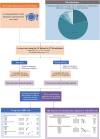Unprocessed Red Meat and Processed Meat Consumption, Plasma Metabolome, and Risk of Ischemic Heart Disease: A Prospective Cohort Study of UK Biobank
- PMID: 36974753
- PMCID: PMC10122901
- DOI: 10.1161/JAHA.122.027934
Unprocessed Red Meat and Processed Meat Consumption, Plasma Metabolome, and Risk of Ischemic Heart Disease: A Prospective Cohort Study of UK Biobank
Abstract
Background The evidence is equivocal on the association between meat consumption and ischemic heart disease (IHD) risk. To what extent the variation of individuals' metabolic responses to the same diet may account for this association is not fully understood. We aim to identify metabolomic signatures characterizing consumption of unprocessed red meat and processed meat and whether such signatures are associated with IHD risk. Methods and Results We conducted a cohort study of 92 246 individuals (mean age, 56.1 years; 55.1% women) using the UK Biobank. During the median follow-up of 8.74 years, 3059 incident IHD events were documented. Unprocessed red meat and processed meat consumption was assessed using a touchscreen dietary questionnaire. Plasma metabolome was profiled by high-throughput nuclear magnetic resonance spectroscopy. Cox proportional hazards regression model was used to test the association of meat consumption with IHD. Genome-wide association analysis and 1-sample Mendelian randomization were performed for metabolomic signatures and causal association of signatures with IHD. Using elastic net regularized regressions, we constructed metabolomic signatures consisting of 157 and 142 metabolites for unprocessed red meat (Spearman correlation coefficient [r]=0.223) and processed meat (r=0.329), respectively. These signatures showed positive associations with incident IHD (red meat related signature: hazard ratio [HR] per SD increment=1.11 [95% CI, 1.06-1.16], P<0.001; processed meat related signature: HR, 1.16 [95% CI, 1.11-1.21], P<0.001). Genome-wide association studies identified 45 and 4 loci, involved in lipid and lipoprotein metabolism, for red and processed meat related signatures. Mendelian randomization showed that there were casual associations of signatures with risk of incident IHD. Conclusions We identify metabolomic signatures that reflect consumption of unprocessed red meat and processed meat, and these signatures are associated with an increased risk of IHD.
Keywords: Mendelian randomization analysis; genome‐wide association analysis; ischemic heart disease; meat consumption; metabolomics.
Figures




References
-
- Kyu HH, Abate D, Abate KH, Abay SM, Abbafati C, Abbasi N, Abbastabar H, Abd‐Allah F, Abdela J, Abdelalim A, et al. Global, regional, and national disability‐adjusted life‐years (DALYs) for 359 diseases and injuries and healthy life expectancy (HALE) for 195 countries and territories, 1990–2017: a systematic analysis for the Global Burden of Disease Study 2017. Lancet. 2018;392:1859–1922. - PMC - PubMed
-
- World Health Organization . Atlas of heart disease and stroke. 2022. Accessed January 30, 2023. https://www.who.int/data/gho/publications/world‐health‐statistics
-
- Lewington S, Whitlock G, Clarke R, Sherliker P, Emberson J, Halsey J, Qizilbash N, Peto R, Collins R. Blood cholesterol and vascular mortality by age, sex, and blood pressure: a meta‐analysis of individual data from 61 prospective studies with 55,000 vascular deaths. Lancet. 2007;370:1829–1839. doi: 10.1016/S0140-6736(07)61778-4 - DOI - PubMed
-
- Public Health England . The Eatwell Guide. London: Public Health England; 2016. Accessed January 30, 2023. https://www.gov.uk/government/publications/the‐eatwell‐guide
Publication types
MeSH terms
LinkOut - more resources
Full Text Sources

